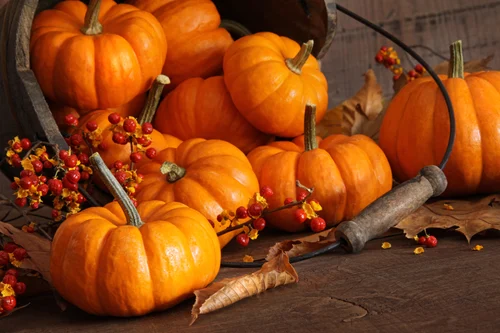Pumpkin Health Benefits (And Ways to Prepare It)
With pumpkin growing contests, pumpkin carvings, pumpkin pie, and pumpkin spice everything, it’s no wonder pumpkin is so popular. Not only is it fun, seasonal and yummy, it is also very nutritious! Pumpkin has few calories and is rich in Vitamin A and other vital antioxidants. Some even consider pumpkin a super food.
Health Benefits of Pumpkin
- 1. Keeps your vision healthy. A single cup of pumpkin contains about 197% of your daily vitamin An intake. Vitamin A plays an important role in keeping your vision healthy by protecting the surface of your eye. Vitamin A can also help decrease your risk of macular degeneration keeps your skin healthy and promotes bone health.
- 2. Helps you sleep. Pumpkin contains an amino acid called tryptophan. This is the same amino acid found in Turkey so it will help induce sleepiness.
- 3. May lower blood pressure. One study found that individuals on a high-fiber diet experienced a drop in blood pressure and pulse pressure. So in addition to helping your cholesterol levels (see next!), the pumpkin will also help keep your blood pressure levels in check.
- 4. Keeps your heart healthy. All the fiber that is found in pumpkin can also help keep your heart healthy. Fiber can reduce both “bad” cholesterol (LDL) and overall cholesterol. Scientists believe this is because it binds with cholesterol particles and then removes them from the body through the digestive system before it’s absorbed.
- 5. Pumpkin keeps you full. Including pumpkin in your diet may help you lose weight. Pumpkin contains fiber which also helps promote fullness and staves off hunger.
- 6. Mood booster. Pumpkin contains tryptophan, which is an amino acid that helps the body produces Serotonin. Serotonin is a neurotransmitter that is responsible for influencing things like mood, sleep, and even memory. Also known as the “feel good” chemical, when you have more serotonin, it’s likely that your mood will improve!
- 7. Antioxidants in abundance. Remember how much Vitamin A pumpkin has? It’s a powerful antioxidant that some research says it helps fend off cancer. Beta carotene, which converts to vitamin A, helps protect our cells and boosts immune system function.
How to Prepare Fresh Pumpkin
- Choose smaller pumpkins! Smaller pumpkins are more flavorful and work better in recipes than the large ones that we typically use for carving.
- Choose your method. Will you use the baking method, boiling method, or microwave method? This article from AllRecipes.com has excellent instructions on all three!
- Basic Prep: Cut the pumpkin in half, discard the stem, and remove seeds and pulp.
Baking Method:
Place the two halves face down in a baking dish and cover with foil. Bake at 375 F for 1 ½ hours, or until tender. Once the pumpkin has cooled, scoop out the flesh and purée.
Boiling Method:
Peel the pumpkin and cut it into chunks. Place the chunks in a saucepan, cover with water and bring to a boil. Cook until tender, cool, and mash or purée in a food processor.
Microwave Method:
Microwave on high for seven minutes per pound. Turn pieces every few minutes so that they cook evenly. Purée or mash
Source: www.positivehealthwellness.com








